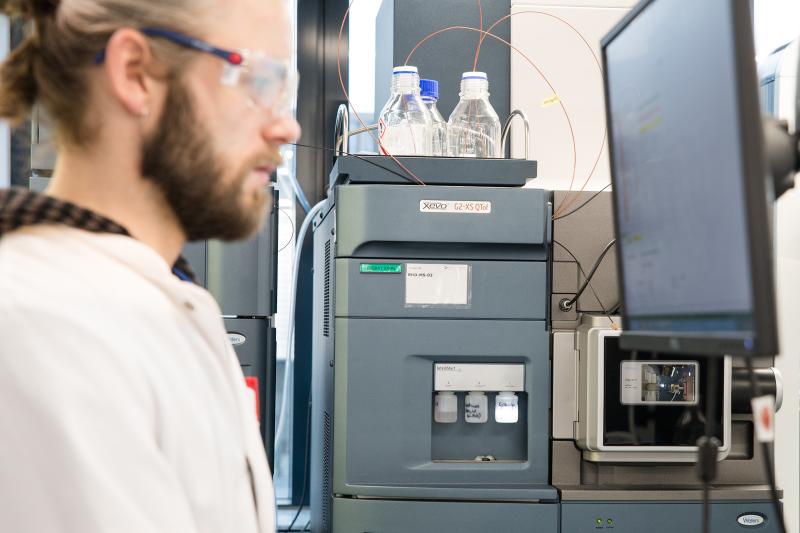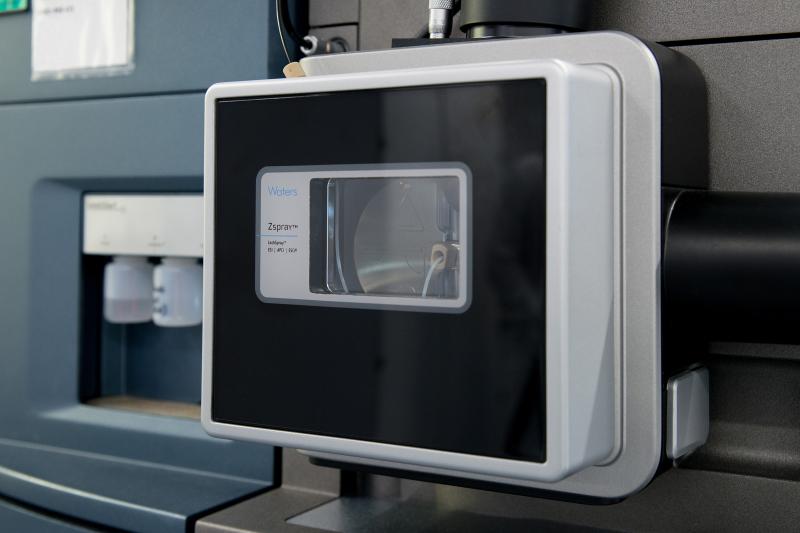Liquid chromatography coupled mass spectrometry (LC-MS)
LC-MS - A Highly Versatile Technique
Mass spectrometry separates ionized molecules according to their mass-to-charge ratio. In combination with a-priori knowledge on the sample, LC-MS analysis allows to obtain a comprehensive insight of your sample on a molecular level.

With our high-resolution quadrupole time-of-light (TOF) mass analyzers, coupled with a Ultra-High-Performance Liquid Chromatography (UPLC), various analytical questions can be targeted. Most important for pharmaceutical industries are the characterization and quantification of active pharmaceutical ingredients (API) (of small and large molecule scale) as well as formulation excipients such as surfactants (polysorbates (PS)), saccharides and amino acids. Each of our systems is dedicated to a particular analytical target.

Large Molecules
Antibodies or proteins in general can be analyzed on an intact level (intact mass analysis also known as top-down approach) or after proteolytic digest on a sub-unit level (middle-up approach) as well as on a peptide level (bottom-up approach). Typically, reversed phase (RP) chromatography is used to desalt the sample (e.g. in case of intact mass analysis) or to separate protein fragments on basis of hydrophobicity from each other. Application of volatile buffer systems also allows size exclusion chromatography for aggregation analysis and ion exchange chromatography for analysis of protein charge variants.
Altogether, the method portfolio at Coriolis can be used for biosimilar characterization (e.g. head-to-head comparison of biosimilar and innovator), analysis of post translational modifications (e.g. C-terminal lysine clipping) and degradation monitoring during stability studies (e.g. deamidation, oxidation).
Often, several critical quality attributes (CQA) like oxidation, deamidation and glycation can be accessed via one single method, which also referred to as multi attribute monitoring (MAM) method.
Small Molecules
Surfactants are in many cases an integral part of biopharmaceutical formulations and crucial for API (e.g. protein) stability during pharmaceutical product shelf life. One of the most common surfactants used in biologics is polysorbate 20 (PS20) or polysorbate 80 (PS80) both are typically used to prevent protein absorption on surfaces and protein aggregation induced by interfacial stresses. Yet, PS degradation can also lead to formation of particles. Major root causes for PS degradation are i) the inherent tendency for auto-oxidation and ii) residual host cell membrane proteins with enzymatic activity that hydrolyze the PS ester bonds. Therefore, close monitoring of PS throughout the shelf life of the pharmaceutical product is essential. Coriolis owns profound experience in the field of PS quantification, characterization and monitoring. At Coriolis PS analysis is conducted with help of LC-MS (for in-depth characterization) and LC-charged aerosol detection (CAD) (for high throughput screening). Also, quantification of other buffer excipients such as amino acids or saccharides can be conducted with help or RP or hydrophilic interaction liquid chromatography (HILIC) coupled to MS or CAD. LC-MS can also be applied to monitor small molecule APIs and to characterize degradation products “popping up” during stability studies with help of tandem MS.
Need more information? Follow the links below and contact our experts with your questions today.
Contact us
Contact us
Need more information? We are happy to answer your questions!
Phone: +49 89 41 77 60 – 111
Mail: joerg.mueller@coriolis-pharma.com


